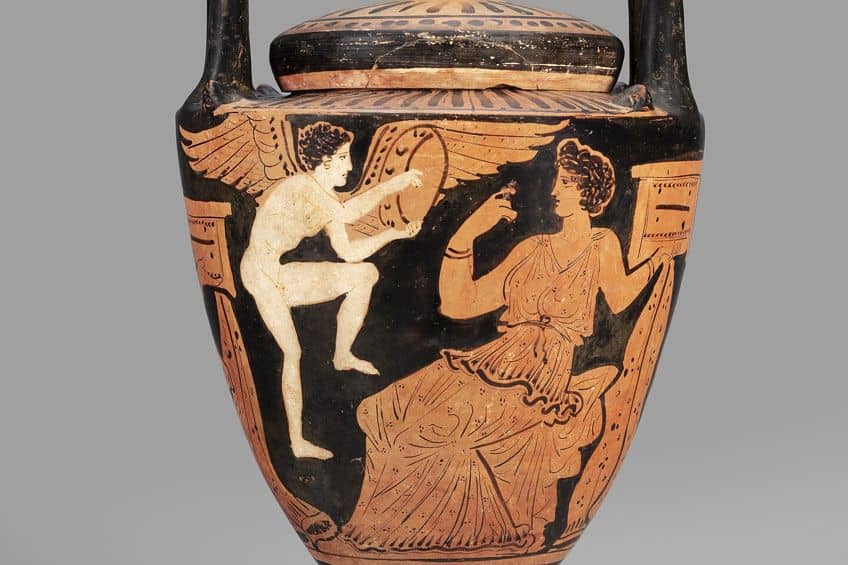Greek Pottery – The History of Ancient Greek Vase Designs
Ancient Greek pottery reveals some of the most complex and fascinating aspects of Greek culture that will keep you captivated. As an art form appreciated for its beauty, technical handling, and storytelling capabilities, the world of Greek pottery has much to share. In this article, we will delve into the history of Greek pottery by reviewing the different styles found in Greek pottery, as well as the décor and types of artwork found on ancient Greek vessels. Keep reading for all you need to know about Greek pottery!
Exploring the Origins of Pottery in Ancient Greece
The ancient Greeks were among the most influential civilizations in the world to leave a significant mark on the arts. From architecture to painting, the ancient Greek art world was populated with artisans and talented craftsmen who drew attention to mediums like clay and stone and created many ornate and functional vessels, which were also important in the trade and transportation of goods. Ancient Greek pottery dates back to the Neolithic era, around 6000 BCE, and has since evolved in style throughout the Bronze Age and Classical periods. Civilizations such as the Minoan, Mycenean, and Athenians created pottery that represented all aspects of Greek culture and tradition.

Greek pottery and art go hand-in-hand when it comes to subject matter and the fusion of traditional art styles into sculptural forms created for functional purposes. Pottery created in ancient Greece varied in style and displayed distinct characteristics. The most popular styles include the geometric style and the later Orientalizing style, which was inspired by Eastern cultures and incorporated new animal and floral motifs. Techniques such as the black-figure and red-figure-style pottery saw artists include more realistic and detailed decorations and painted scenes that were further decorated with incisions. By studying Greek pottery, scholars can understand the inner workings of Greek society, since many Greek vessels included artworks with scenes from Greek daily life, mythology, history, and religious practices, which are important aspects of any civilization. Pottery was an art form that was not only functional but also precious in its storytelling abilities, which made them works of art. Ancient Greek pottery was a tool for cultural expression that provides us with many clues about the social structures, artistic developments, trade networks, and gender roles found in Greek civilizations.
Today, one can appreciate the discoveries of archaeologists and historians who study, analyze, and reconstruct these art objects so that one can explore the iconography and complex symbolism of a culture that largely influenced Western art.
Common Materials and Techniques in Greek Pottery
Ancient Greek potters employed various types of clay, techniques, and styles to create some of the most elaborate and stunning Greek vessels. Materials such as clay combined with clips and glazes were important to the final aesthetic of the vessels. Terracotta was one of the most common types of clay used in Greek pottery that varied in color depending on the mineral content of the clay when fired. Terracotta-fired Greek vessels ranged in color from yellow to deep red and could be crafted in a variety of shapes and sizes. Slip was another liquid clay suspension that was applied to surfaces to create different effects. Black slip was also common in the production of black-figure pottery and created using a mixture of clay and water, which was then applied to a clay vessel and incised to reveal the reddish-orange color beneath it.

Greek pottery art encompassed vase painting and decoration, which included the use of various glazes and pigments to achieve different visual effects in ancient Greek pottery designs. The black glaze was a popular choice for artists and resulted in a glossy finish. The technique was common throughout the Late Archaic and Classical periods. Between the 7th and the 5th centuries BCE, the black-figure technique thrived and involved the creation of designs using a diluted clay slip. The late 6th century saw the development of the red-figure technique in Greek pottery art, which produced many Greek vases designed with detailed and ornate illustrations. In this technique, the vessels were painted black while the figures were left in the original red color. Another well-known technique in Greek pottery art was the white-ground technique, which artists used to paint scenes in various colors on a white background.
Other artists employed a bilingual approach and fused the black and red figure techniques to create a unique piece.
Different Types of Greek Pottery
Greek pottery was not developed overnight. It took centuries for each style and technique to be perfected and soon, there were many different types of vessels produced for different purposes. From ceremonies to functional drinking vessels, below, we will explore the different types of Greek pottery that will help you identify form and function.

Kylix
The Kylix was a type of ancient Greek vessel used for consuming wine. This drinking vessel was characterized by a wide body, two handles on either side, and a tall foot.
Amphora
Perhaps the most well-known type of Greek pottery is the amphora, which is characterized by its size and shape. Amphorae were used to store liquids and were crafted with a stylized shape characterized by a wide base, a tapered neck, and a tall or oval-shaped body.
The decoration of amphorae was significant to the education of those who owned it since it portrayed both scenes from mythology and history through detailed reliefs on the vessel’s surface.
Lebes
The Lebes vessel was a type of vessel used for the storage of water or for religious ceremonies where water would be mixed with wine. The vessel was crafted with a wide base for extra stability and was painted with processional scenes and other cultural motifs.
Hydria
Greek potters created hydrias to transport and pour water. These vessels were created with three handles to evenly distribute the weight of the load and were a convenient choice for Greeks to carry and transport large quantities of water.

Lethykos
The lekythos vessel was a type of storage jug that was used to store olive oil. The jug was also used in ceremonies and funerals and was characterized by a long neck and handle attached to the neck.
Kraters
The krater was a type of Greek pottery used to mix wine and water at events such as banquets or symposiums. These types of vessels were created with two vertical handles with an opening on the vessel to allow one to pour liquid into the vessel. Kraters were typically decorated with banquet scenes, animal motifs, and festive imagery.
Greek potters also invented the bell-shaped krater, which had a wider base with a shorter body, and often featured battle and sports scenes.
Kantharos
Also known as a cantharus, is the kantharos vessel, which was a basic drinking cup with two handles. These types of vessels were used primarily for drinking and were often crafted from metal.
Oinochoe
The oenochoe vessel refers to a wine jug and was a type of vessel that merged the designs of the amphora and the individual cups. Oenochoe vessels stored liquid for up to several individuals until it could be used. These types of jugs were designed specifically for wine pouring.

Common Greek Pottery Styles
Using the different techniques discussed above, Greek artists were able to create many functional vessels that also demonstrated their passion for the arts and the significance of different aspects of Greek culture.
Below, we will discuss the different Greek pottery types and styles in detail, which will help you understand the different functions of pottery in Greek society.
Geometric Pottery
One of the most well-known styles of ancient Greek pottery was the geometric style, which thrived between the 9th and 8th centuries BCE. Geometric pottery included the use of geometric designs and patterns such as concentric circles, zigzag lines, meanders, and triangular shapes. Artists who worked in the geometric style also used stylized representations of humans and animals portrayed with elongated forms. Greek vases designed with geometric styles included clay-fired vessels such as hydriae, cups, kraters, and amphorae. The Dipylon Amphora (c. 750 BCE) is one such example of the style that was named after the Dipylon Gate in Athens. The amphora portrays detailed scenes of funeral processions, mythological figures, and animals arranged in registers. The Hirschfeld Workshop was also associated with Attic vase art from the geometric period.

Ancient Greek pottery designs found on Geometric vases included the checkered pattern and various geometric shapes that were created using a combination of techniques involving pigments made from iron oxides and incisions on clay. The function of geometric pottery was primarily utilitarian and was also used in funerary and ritual events. Artists portrayed human and animal figures with triangular bodies and abstract designs that were usually positioned in bands or rows around the vessel. While the symbolic meaning of most geometric Greek vase patterns is not completely understood, they were likely to possess cultural or religious meanings. A few common symbols included meanders, which represented the concept of infinity and were seen as a flowing body of water.
Stylized birds were also found in geometric pottery and were attributed to mythological or ritual associations.
The Orientalizing Style
The late 7th century saw a massive influence from the Near Eastern regions of Mesopotamia and Egypt. The Orientalizing style lasted until the early 6th century and saw the incorporation of motifs and techniques from Eastern culture into ancient Greek vases, which led to more ornate decorations. The Corinthian Aryballos (c. 6th century BCE) is one such famous vessel recognized for its Egyptian and Near East-inspired designs. The vessel features designs such as lotus flowers, which are clear influences from the East.
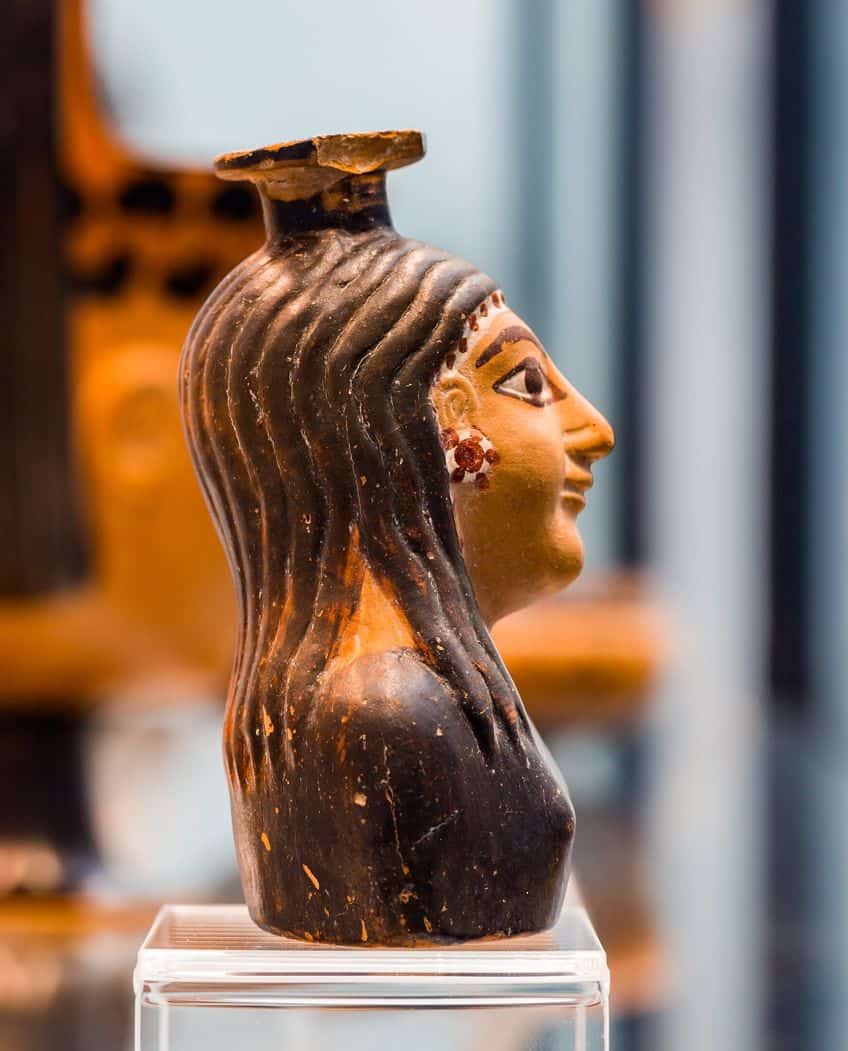
Ancient Greek pottery designs for the Orientalizing style introduced new symbols to Greek pottery, including sphinxes, griffins, palmettes, rosettes, and lotus flowers. Mythical and real animals were portrayed in a more fluid form, which indicated a rise in storytelling features in Greek art. Cultural and trade relations between Greece and the Eastern Mediterranean also influenced the style of the Orientalizing period and saw Greek artists embrace foreign art through their fascination with the idea of “exotic” design to show off themes of wealth and luxury.
The Orientalizing style proved to be incredibly impactful on the developments of the Archaic period and continued to influence the visual vocabulary of many Greek artists.
Corinthian Pottery
This type of pottery was popular during the Oriental period and is also known as the proto-Corinthian style. Corinthian pottery thrived during the 8th and the 7th centuries and was characterized by its distinct yellow clay with black-figure decorations. Popular motifs in Corinthian pottery featured motifs from Eastern cultures and were miniature in size compared to other styles. Corinthian vessels were among the first types of vessels to be painted in the black-figure style.
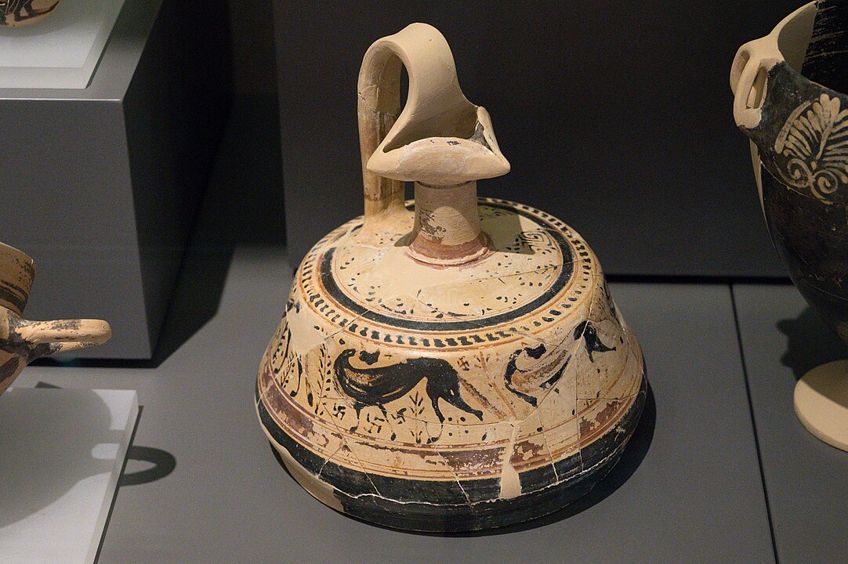
Black-Figure Pottery
Between the 7th and the 5th centuries BCE, black-figure pottery dominated Greek pottery and was named after its unique visual appearance of black figures rendered on a reddish-orange background. For black-figure pottery, figures were outlined in incised lines with internal marks and details added using a diluted clay slip. This style enabled artists to add more detail to their compositions and more expression to human figures. The distinct appearance of the vessel flourished in the 6th century and was a significant development in Greek ceramic art. The black slip that was applied to a vessel for its background obtained its dark color by firing due to the oxidizing atmosphere of the kiln.
A pioneer of the Attic black-figure vase painting style was the Nessos painter, who was the first Athenian artist to adopt the Corinthian style.
Types of vessels that featured black-figure designs included amphorae, kraters, lekythos, and kylikes, all of which served different functions in funerary offerings, liquid storage, and the mixing of wine and water. Famous Greek potters such as Exekias, Lydos, and the Andokides painter, were renowned for their talents in black-figure pottery. The potter Exekias was widely celebrated for his finely detailed work on vessels, which featured mythological scenes and characters. The element of symbolism was a major aspect of black-figure pottery since the vessels often portrayed Greek gods and scenes from mythology that were part of daily life and culture. These black-figure painted images were not only decorative, but also visually represented religious messages, political ideals, stories, and social beliefs.
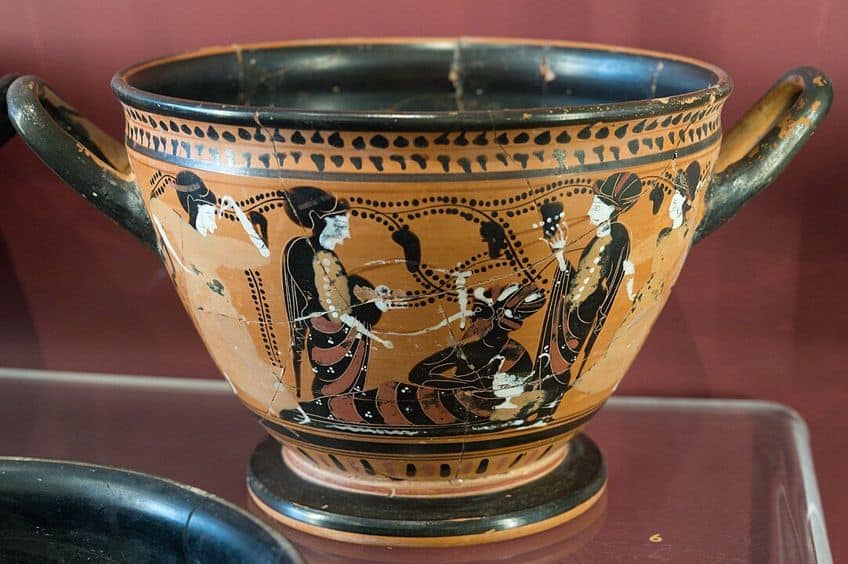
Red-Figure Pottery
Following the developments of black-figure pottery came red-figure pottery, which thrived in the late 6th century BCE and lasted until the 4th century BCE. Red-figure pottery was a reversal of the methods used in black-figure pottery. In red-figure pottery, the background was painted black and the figures were left in the natural reddish-orange color of the clay. This approach enabled more naturalistic and realistic details, which were rendered with a fine brush. Famous Greek potters who specialized in red-figure pottery included Euphronios, Douris, and the Berlin painter. The artist Euphronios was best known for his meticulous attention to anatomical details and his collaboration with pottery painter Euxitheos, who created the Sarpedon Krater.
Douris was another artist who specialized in religious scenes and everyday subjects while a graceful approach was adopted by the Berlin painter.
As seen in black-figure pottery, red-figure pottery featured a wide range of subjects. These included mythology, daily life, athletics, heroes, gods, and mythical creatures. Other recognizable scenes from daily life included banquets, theater performances, and athletic contests with symbols associated with specific gods and heroes. Red-figure vessels served different functions, including their general use as containers, and offering vessels. They were also included in grave goods with lekythos used for funerary offerings. Kylikes, also known as drinking cups, were used in drinking parties called symposia and featured paintings related to wine, revelry, and the God, Dionysus.

White-Ground Pottery
White-ground pottery originated around the late 6th and early 5th century BCE and was created using a white slip that was coated on a vessel to create a blank canvas for the artist. Using white slips enabled artists to depict scenes in a variety of colors to showcase their abilities in creating detailed works. White-ground pottery featured scenes from mythology, daily life, and rituals. This style of pottery was used to store precious substances and used in funerary offerings.
White-ground pottery was associated with commemorating the dead since it was commonly discovered in tombs.
Funerary scenes portrayed on these types of vessels included funeral processions, mourning figures, and images of the deceased. Mythological scenes emphasized the underworld and everyday scenes featured women engaged in musical performances and activities like weaving. The Berlin painter was also known to work in white-ground pottery as well as the Achilles painter, who was famous for his depiction of the hero Achilles. Colors such as red and yellow were common in white-ground vessel paintings and are known as polychromy, which enhanced the artwork.
Famous Ancient Greek Vessels
These unique Greek pottery styles showcased the culture and societal beliefs of the civilizations that thrived as early as the 8th century BCE. Below, we will review a few examples of famous ancient Greek pottery that beautifully illustrate the talents of Athenian potters and vase painters.

Terracotta Krater (c. 750 – 735 BCE)
| Artist Name | The Hirschfeld Workshop |
| Date | c. 750 – 735 BCE |
| Medium | Terracotta |
| Dimensions (cm) | 108.3 x 72.4 |
| Where It Is Housed | The Metropolitan Museum of Art, New York City, United States |
This highly stylized ancient Greek vase is an example of the craftsmanship of potters from the Hirschfeld workshop, who specialized in geometric decoration. The krater was a funerary vase, which depicts individuals mourning for the deceased with their arms painted upwards in the geometric style. All the figures are painted in geometric shapes that mimic the abstract geometric designs of the rest of the vase and represent a cohesive work of art that showcases the fine quality of Attic pottery. Stone sculptures were originally used as funerary monuments during the Archaic period.
Scholars believe that this krater was possibly an honorary symbol of the deceased’s military, ancestral, and social contributions.
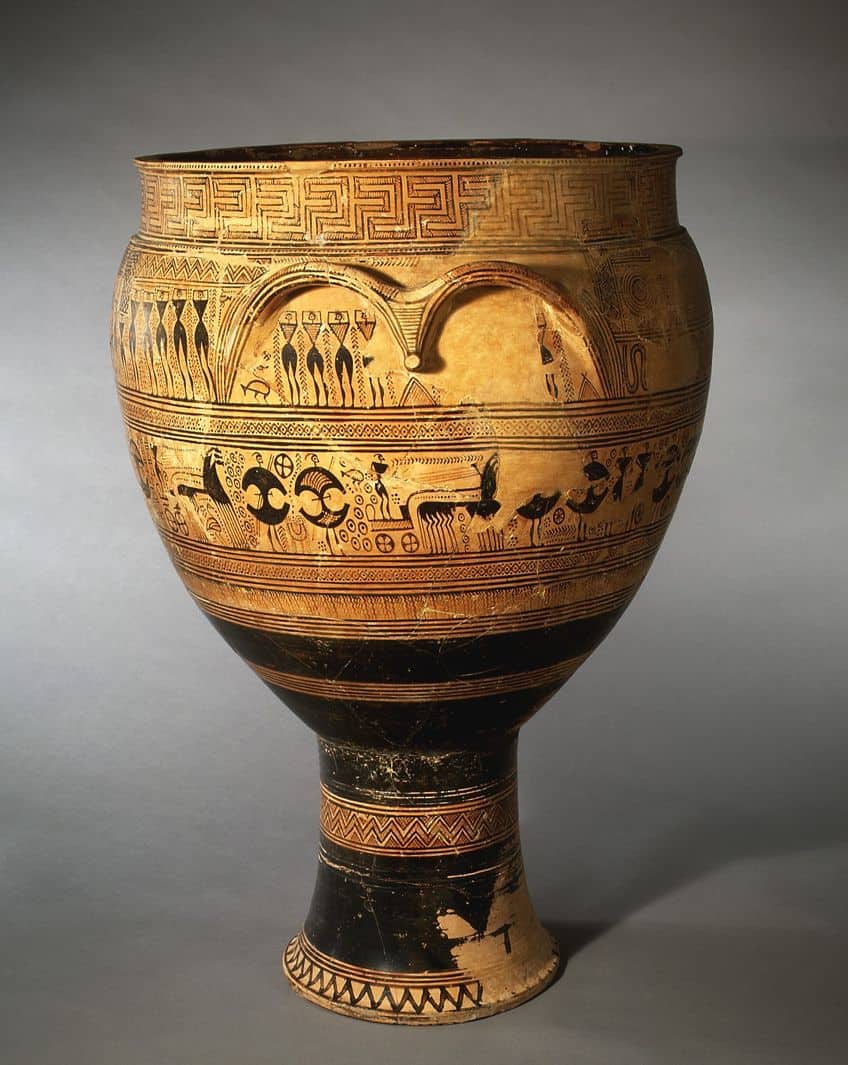
Terracotta Amphora (c. 490 BCE)
| Artist Name | The Berlin painter |
| Date | c. 490 BCE |
| Medium | Terracotta |
| Dimensions (cm) | 41.50 (h) |
| Where It Is Housed | The Metropolitan Museum of Art, New York City, United States |
Created by the Berlin painter, this striking terracotta amphora showcases the height of Greek vase painting. The vessel was created in the late 5th century and portrays an image of a singer playing a kithara. A kithara was an instrument used in ancient Greek performances and recitations of epic poems. There are two figures on the vase, each of which was painted in competition with the other. The theme is believed to be the music itself, which is only present through the illustration of the instruments and the pose of the performer, who appears to sway gently to the melody.
The Berlin painter was an Athenian artist who was recognized as one of the best vase painters of the Late Archaic era.
The unknown artist received their nickname from an amphora in the Berlin museum, which was attributed to the artist and demonstrated their elegant approach to pottery. The Berlin painter had a tremendous influence on the pottery styles of artists who operated in the 6th century and red-figure pottery painting. Scholars have marveled at his work and describe his style and approach as executed with dexterous precision, demonstrated on objects large and small. From kraters to lekythos, the Berlin painter portrayed subjects with a single concept on multiple sides of a vessel. A few popular scenes painted by the Berlin painter include cult scenes, performances (sport and music), and mythical heroes and Gods such as Herakles, Athena, and Dionysus.

The Influence of Greek Pottery
Greek pottery and art serve as a rich source of historical data that archaeologists use to study Greek life and culture. Through the examination of ceramic objects such as vases, researchers and scientists can identify a chronology of Greek art, style, and culture, which provides information on the styles of the time and the development of each style over time. By establishing a chronological framework through the study of Greek pottery, scholars can also identify the different ways that ancient Greeks viewed their deities, which further provides information on the obscure myths of the past. Representation in ancient Greek pottery is significant since it outlines the most important aspects of Greek society and sheds light on ways that Greek plays and performances were staged.
Vase paintings also offer insight into everyday Greek life, popular epics, and even specific characteristics of an artist. In Athens alone, there are around 20,000 Greek vases and vessels that provide much insight into the curiosities of Greek life.
Styles such as the Minoan style in Greek pottery proved to be highly influential with their colorful and decorative approach to vase aesthetics. The Minoan style greatly informed the development of the Mycenaean style around 1600 BCE, which evolved into the sub-Mycenaean style and influences from the East. Out of all the types of vessels, ceramics produced in Athens reflected the height of artistic prowess, which were also highly valued in ancient Greek society, and used across social events and religious ceremonies.
Greek Pottery Facts
While pottery is found in almost any civilization in antiquity history, Greek pottery stands out for many reasons. We have compiled a list of Greek pottery facts that summarize the unique qualities of the art form in ancient Greece and will help you identify a Greek vessel from a mile away!
- Ancient Greek vases were produced in multitudes, with the most popular type crafted from Attic clay, which produced an orange-red finish after firing.
- Greek pottery was created for many functional purposes, including practical uses to store perfume, water, wine, and oil. Such liquids were also packed in vessels and transported for trade purposes.
- The traditional styles of Greek pottery encompass the hydria, amphora, pyxis, and pelike
- Contrary to popular belief, Greek pottery also included large drinking vessels without handles or feet and were known as the krater and dinos These vessels were used in male drinking parties.
- The vessels with the longer handles were crafted so that people could pick them up easily, even when lying down, and were known as the phiale, kantharos, loutrophoros, skyphos, and oinochoe
- Greek potters had enough room for creative expression when it came to vases and also produced vessels with long necks and no handles called lekythos, aryballos, and alabastron These vessels were used for cosmetics, oils, and perfumes.
- Greek pottery also encompasses decorative styles such as the proto-geometrical style, geometric art, the Orientalizing style, black-figure pottery, and red-figure pottery.
- The 4th century saw the decline of figure-decorated pottery in ancient Greece and disappeared completely around 320 BCE.
- The earliest stylistic form of pottery emerged around 1000 BCE with the Geometric period and encompassed styles from the Mycenean culture.
- Common Greek vase patterns include the meander, the swastika, triangles, checker patterns, and herringbone, which resulted in abstract pieces.
- During the expanse of trading activities in Greece around the late 8th and early 7th centuries, Greek pottery became increasingly influenced by Eastern art styles and began to incorporate Asian motifs such as curvilinear patterns, and subjects such as the griffin, gorgons, sphinx, sirens, chimera, and the lion.
- The famous silhouette technique was invented by the Corinthian painters who painted figures in a black glaze and incised details using thin lines. This style was adopted by Athenian pottery painters by 630 BCE to depict human figures.
- By 600 BCE, Athens was established as the primary hub of pottery and saw the first instances of Greek potters signing their works.

Greek pottery is a valuable resource for understanding and drawing inspiration from Greek culture. The collective consciousness that thrived between myth, religion, and social practices is a remarkable point of interest from Greek society that continues to intrigue many artists today.
Frequently Asked Questions
What Are the Different Types of Ancient Greek Pottery?
The different types of Greek pottery include vessels such as the amphora, kylix, lekythos, hydria, krater, kantharos, and oinochoe types. These vessels served different practical functions and were characterized by their unique shapes and techniques.
What Are the Different Styles of Ancient Greek Pottery?
The primary styles of Greek pottery include the geometric, Corinthian, black-figure, and red-figure pottery styles, which were all popular in ancient Greece.
Who Are the Most Famous Ancient Greek Potters?
Exekias was considered to be among the most famous Greek potters who specialized in the black-figure style. Exekias is regarded as the finest potter of the 6th century alongside figures like the Amasis painter and the former Berlin painter.
Liam Davis is an experienced art historian with demonstrated experience in the industry. After graduating from the Academy of Art History with a bachelor’s degree, Liam worked for many years as a copywriter for various art magazines and online art galleries. He also worked as an art curator for an art gallery in Illinois before working now as editor-in-chief for artfilemagazine.com. Liam’s passion is, aside from sculptures from the Roman and Greek periods, cave paintings, and neolithic art.
Learn more about Liam Davis and about us.
Cite this Article
Liam, Davis, “Greek Pottery – The History of Ancient Greek Vase Designs.” artfilemagazine – Your Online Art Source. July 31, 2023. URL: https://artfilemagazine.com/greek-pottery/
Davis, L. (2023, 31 July). Greek Pottery – The History of Ancient Greek Vase Designs. artfilemagazine – Your Online Art Source. https://artfilemagazine.com/greek-pottery/
Davis, Liam. “Greek Pottery – The History of Ancient Greek Vase Designs.” artfilemagazine – Your Online Art Source, July 31, 2023. https://artfilemagazine.com/greek-pottery/.


